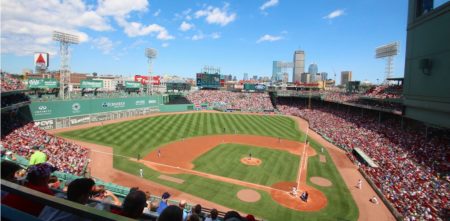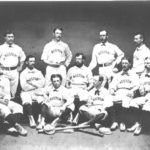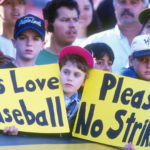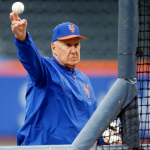Why Baseball Stadiums are the Cathedrals of America
 Even people who don’t follow baseball have heard of Fenway Park and Wrigley Field. The two original baseball cathedrals left in America, dating back more than 100 years from the days of the Titanic sinking in 1912.
Even people who don’t follow baseball have heard of Fenway Park and Wrigley Field. The two original baseball cathedrals left in America, dating back more than 100 years from the days of the Titanic sinking in 1912.
Fenway Park opened on April 20, 1912. While Wrigley Field opened two years later, on April 23, 1914.
At first, Wrigley Field was called Weeghman Park (named after the owner of the Chicago Whales), home of the Chicago Whales, also known as the Chi-Feds because they played in the Federal League. They were the original tenants of Weeghman Park. The Chicago Cubs moved into the Federal League stadium in 1916 after the Federal League disbanded. The field changed its name to Wrigley Field in November 1926.
These two stadiums reek of history and ironically were the sites of baseball’s longest running failures. The oldest stadiums not to play host to a World Series Championship until the Red Sox won in 2004, and the Cubs, finally, in 2016.
All the other old baseball cathedrals had been demolished in the interests of more elaborate shrines dedicated not so much to baseball, as to the next generation of owners who bought those baseball teams to make money.
The best known of those older cathedrals were: Comiskey Park (Chicago White Sox). Ebbets Field (Brooklyn Dodgers). Forbes Field (Pittsburgh Pirates). The Polo Grounds (New York Giants and briefly the New York Mets). Shibe Park (also known as Connie Mack Stadium in Philadelphia, home of both the Philadelphia A’s and Phillies). Sportsman Park (St. Louis Cardinals and St. Louis Browns). And the old Yankee Stadium, the House that Babe Ruth Built in 1923. All of them gone and replaced by stadiums with greater commercial potential.
Replaced by stadiums that added more and more ancillary services that ownership could collect revenues from. Food. Game programs. Team yearbooks. Pennants. Soda. Beer. Frankfurters. Peanuts. Cotton Candy. Baseball caps. And eventually other baseball merchandise like team uniforms and jackets. Or anything with a team logo on it. A list that would grow exponentially as teams understood how to capitalize on fans’ desires to identify with “their” team. Leading up to “official” team branded beer and water in today’s game.
These next generation baseball stadiums were smaller (in dimensions from home plate to the numbers on the outfield fences) and built as entertainment extravaganzas. Actually, even seating capacity has been cut in half. No longer are stadiums built to seat 75,000. Now, 45,000 or 50,000 is more than enough.
And while in the first generation of stadiums, the bars, restaurants, and souvenir shops were built outside on surrounding avenues (like River Avenue outside Yankee Stadium), in the second generation, those businesses began to be included in the overall stadium design as teams realized they could hoard that revenue for themselves.
Today, baseball stadiums are about luxury. High-end stores and restaurants and cafes and outdoor seating areas and bars and lavish clubs created for season ticket holders all inside the stadium. Some stadiums are even attached to hotels built into its design. Anything and everything to increase revenue. It’s as though people now pay higher and higher ticket prices to come to the ballpark to forget why they’re there. To drink. To have fun. And if they see some of the game, so be it. After all, there are television monitors all over the stadium. Even in the bathrooms.
Imagine going to a baseball game and not seeing the game?
But in today’s world, the spectacle’s not the game. The game’s a loss leader, priced so everyone can find an affordable price-point, from the cheap seats in the bleachers to those sitting in the first row behind the dugout. Once the fans are inside, sure the game’s played, but the real excitement’s not on the field.
It’s in the outdoor restaurants where fans can occasionally look at the game while they eat, drink, and amuse themselves. Or in bars spiked around the stadium. Or steakhouses or hibachis built into the experience. Or expensive luxury suites with waiter service where the wealthy can eat and drink in privacy, along with their guests. And team stores that sell anything with the team logo on it for a premium. And even in the concourses outside the field where the ordinary fans wait in line for the prosaic hot dogs, pizza, and nachos sold in vendor stations.
Of course, there are other revenue opportunities. That’s why smaller market teams accept cash and name their stadiums after corporations. The worst name in the major leagues is the Chicago White Sox stadium on the southside of Chicago. It’s called Guaranteed Rate Field. Comiskey Park still sounds better. But in Hawk Harrelson’s immortal lingo, “he gone.” Long gone.
That’s baseball today. The prices are so exorbitant that ordinary fans cannot afford to see the games in the largest markets.
That’s why the newest baseball stadiums are no longer shrines devoted purely to baseball. Even if Fenway Park and Wrigley Field were originally built like the glorious cathedrals of Europe, dedicated to the greater glory of baseball (or a religion, as was the case in Europe), the new stadiums are devoted to premium services for the wealthy.
For those who can afford to sit close to the action. Or drink champagne in their private suite. Or devour a sirloin steak and wash it down with 25-year-old Scotch. Or for those who don’t want to see the game at all. Just be seen by the right people as they converse in luxury hidden in the bowels of the Stadium Club, smoking cigars. Stadiums are now built to accommodate these needs.
Maybe what baseball needs is something it cannot afford. A shorter schedule. Because 82 games cannot create buzz like the pizzazz of one game a week. One big game a week. Eight home games a year. That’s of course what football has.
And it’s why a football game commands more attention. But even football ratings are down. Because when one game a week becomes three games on Sunday, a game on Monday, and a game on Thursday, fans get tired of too much forced hyperbole. They tune out. Not every home game is a must watch. Whether it’s one of eight, or one of 82. Some are duds.
Unlike football, baseball has an advantage. It’s a religion. A commonsense set of ideas to make sense of the world. A way for Americans to agree on the foundations of what is, and was, important, beginning at a time when most baseball players were immigrants learning to become Americans. Because from its earliest beginnings, baseball was a language of Americana. A chance to embody American values. A way to fit in. Become a next-door neighbor. And earn a decent living.
Babe Ruth. Honus Wagner. Christy Matthewson. Walter Johnson.Connie Mack. John McGraw. Ban Johnson. And the list goes on and on.
Baseball’s now a way to share and address the larger issues of living. See how different ethnic groups coexist. And that’s why these 15 different baseball stadiums are cathedrals of possibility. Not that every team will win the pennant. Only two will. But every team exudes the best of what America stands for. Perseverance. Hard-work. Cooperation. Respect. Intelligence. Craft. And the spirit of success. For six months a year Americans find solace and meaning in the dramas that occur inside the frames of three outs and nine innings. And then they relive the old moments during the offseason, just to be sure.
Before planning their next trip to a cathedral come next year.

























